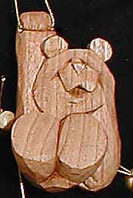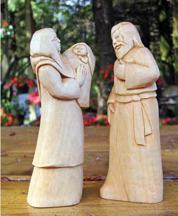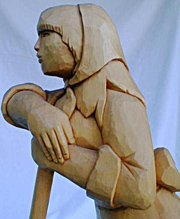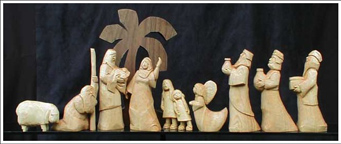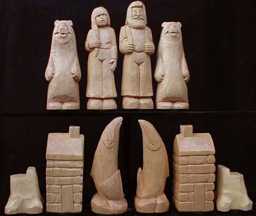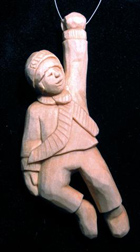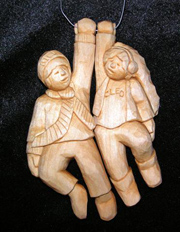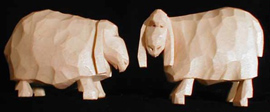
I must admit that what first piqued my interest was Christine Coffman‘s disarmingly simple description of her wood carving career. “I’ve been carving for 44 years, since I was 12,” she summed up in one short line. A quick visit to her web site revealed a seemingly endless array of tiny wood carvings that can only be described as adorable. Intrigued, I called her to get the whole story. “A lot of people tell me my carvings make them happy,” she admitted. “The bears are a good example. They are just pure fun.”
“I really did start carving at 12,” Christine insisted. “In sixth grade, I had a social studies project in which we were supposed to make something historical. I made a three-dimensional carving of donkey pulling a cart. I used wood and a knife borrowed from my father, and a pattern he found in Popular Mechanics. It was good enough that the teacher asked me ‘Did you really do this?’ But I had done it, and that started a lifetime hobby.
“I have been carving ever since, and while most were given away initially, I managed to make at least one early sale. My very first sale was a carving of an angel to an English teacher. I made it in the art room at my school while I was in twelfth grade and sold it to the teacher for 25 dollars. After that one sale, I continued carving but stopped selling. I started giving my carvings to relatives, who were very supportive considering what my early carvings looked like.
“I finished high school in 1969, got married in 1970, and had kids in 1974 and 1976. Carving survived as a hobby because it was quiet and was easy to quickly set down and pick up later. That was important with young children as they tend to need you a lot and immediately. During the next 20 years, carving was simply an enjoyable pastime, and I spent those years learning constantly.
“I would occasionally put my carvings in shows, but because I had a family, only those close to home. At that time, it was popular for shopping malls to have small shows. That helped me learn how to market my work. I’d also go to local shows, like the Northwest Carver’s show, and occasionally sold pieces at the shows. However, those shows are more for sharing with and learning from other carvers than as a profit-oriented activity. I enjoyed them, especially meeting other people who do this work, but I aspired to do larger shows.
“I got a business license to be able to do larger shows in 1988. That same year, my work was accepted for the prestigious Edmonds Art Show, a juried show in the Pacific Northwest. I entered a nativity into the show, and an art dealer bought it. That encouraged me to go to other shows.
“The very first year that the Puyallup Fair allowed wood carvings into their fine art division, I submitted a grouping of three washerwomen. It won first place. Prior to that year, the fair regarded carving not as art but only as a displayable hobby. I guess you could say I won the very first first-place carving ribbon ever awarded in the fine arts section of the Puyallup Fair.
“After that, I started carving as a business. My brother made me a web site, which helped, but a serious market softening was in store. Shortly after 9/11, the attitude of middle income workers toward buying frivolous luxury items, like my carvings, changed, and the market softened considerably. At the same time, three of our parents started having health issues that ate up much of my free time. The combination of events left me making only special orders, and I stopped building inventory for carving shows.
“It’s been a slow process, but I am once again starting to grow the carving business and started going to shows again. In part, going to shows is necessary to let people know you exist. I try to build inventory not only to sell, but to inspire custom orders. At this point, about half my work is on commission. Fortunately, some people look at my work and realize that in spite of its small size, it is original sculpture. People often buy nativity scenes not as gifts, but for themselves, and they often become family keepsakes that the owners revere for years.”
Her work is almost entirely by hand, and uses only rudimentary tools. “I have a 14 inch band saw for cutting wood to rough silhouette,” Christine explained, “and a drill press which I mostly use for adding weights to chess men. Those are the only power tools I own. For small carvings, I use Warren tools, a system that consists of a holder that takes a variety of differently shaped disposable carving blades. Last year, I bought two gouges, which I use for larger work. In part, they are to compensate for my losing strength in my hands. Larger gouges let you use your arms and body as well.”
I asked her which pieces were her favorites and got a special treat. Not only did she answer the question, she also shared the story of a very special pair of carvings she had done recently.
“I love carving nativity scenes, and I make them all different,” she replied. “I also like doing soft images that capture a moment of action or a moment in time and suggest motion. Someone once said my pieces often look like I bent the wood gently instead of cutting it. But perhaps my favorite is a pair of ornaments. Two years ago, a soldier in Iraq asked for two ornaments that would each stand alone as carvings, but when put together, once he got home, would nest together as a single unit.
What is it about carving that has held her attention and devotion for 44 years? “Wood is warm and lasting and beautiful,” Christine summed up, “and carving it gives a wonderful feeling of satisfaction once it is done. I’m pretty sure that years and years from now, my customers’ greatgrandchildren will still be handling my pieces. I just find it incredible to think that some day someone will look at one of my carvings and wonder about the person who created it.”
